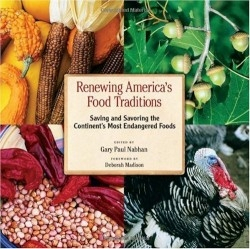Renewing America's Food Traditions
Saving and Savoring the Continent's Most Endangered Foods
Most conservation efforts appeal to ethics or emotion. It’s not often the argument is made to save an animal or a plant because it’s tasty, but that is exactly the consumer/gut driven conservation message of the Renewing America’s Food Traditions (RAFT) collaborative.
We want you to sense how deeply linked these foods are to the health, wealth, gustatory pleasure, and spiritual well-being of America’s diverse communities. In that manner, perhaps, people of many colors and walks of life will feel motivated enough to keep them in our bays and streams, on our mountains and prairies, and in our root cellars and larders forever.
Dividing the United States, plus some of Canada and some of Mexico, into thirteen food nations named after one of the icons of that nation (e.g. the Salmon Nation of the Northwest), the book details several of each nation’s endangered foods. Set up in an encyclopedia format, each entry provides a history of the food, how it came to be endangered, images of the plant or animal, any remaining commercial outlets for stock, and a bibliography. Most often, a historical recipe, or one from modern chefs who have readopted the food, is provided. Examples include Devonshire Cream, Crow Bison Cattail Stew, Englemann’s Oak Acorn Burritos, and Goliath Grouper Chowder.
Nabhan is the founder of the RAFT collaborative, whose partners include the American Livestock Breeds Conservancy, Slow Food USA, and Seeds Savers Exchange. He has written twenty books, including Coming Home to Eat: The Pleasures and Politics of Local Foods. Among numerous awards, he has earned a MacArthur “genius grant,” a Pew scholarship for Conservation and the Environment, and a lifetime achievement award from the Society for Conservation Biology.
Even though only a tiny fraction of the 1,080 seeds, breeds, and populations of threatened, endangered or extinct plants and animals are represented in this book, the current poverty of the average diet and how vast a cultural treasure is on the brink of being lost is plainly evident. As the helpful appendix on community-based conservation frighteningly points out, “fewer that thirty plants provide 90 percent of the world’s nutrition.” This book serves both as a terrific platform for appreciating the astounding food diversity of North America and a first necessary tool for a successful consumer-based conservation of it.
Reviewed by
Naomi Millán
Disclosure: This article is not an endorsement, but a review. The publisher of this book provided free copies of the book to have their book reviewed by a professional reviewer. No fee was paid by the publisher for this review. Foreword Reviews only recommends books that we love. Foreword Magazine, Inc. is disclosing this in accordance with the Federal Trade Commission’s 16 CFR, Part 255.

